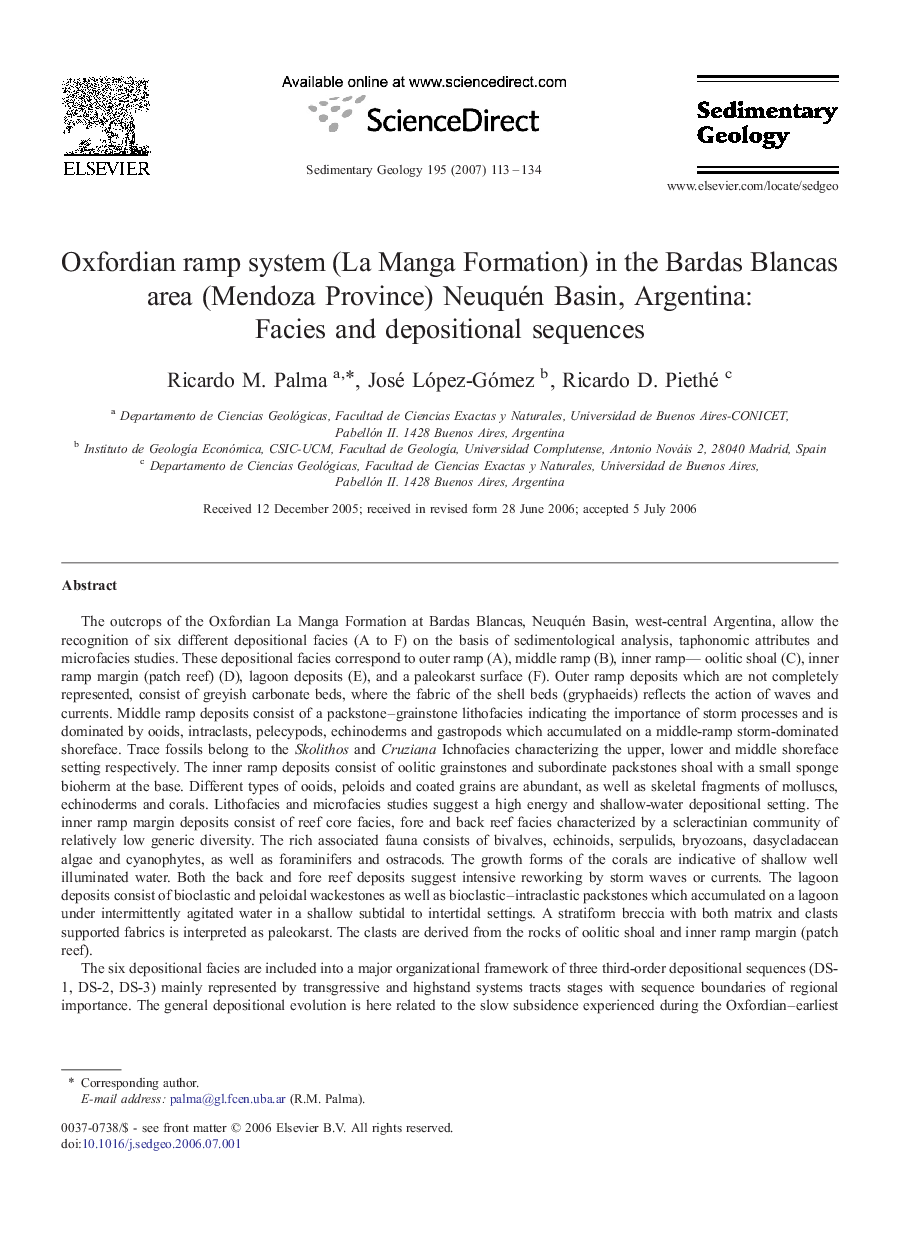| کد مقاله | کد نشریه | سال انتشار | مقاله انگلیسی | نسخه تمام متن |
|---|---|---|---|---|
| 4690951 | 1636174 | 2007 | 22 صفحه PDF | دانلود رایگان |

The outcrops of the Oxfordian La Manga Formation at Bardas Blancas, Neuquén Basin, west-central Argentina, allow the recognition of six different depositional facies (A to F) on the basis of sedimentological analysis, taphonomic attributes and microfacies studies. These depositional facies correspond to outer ramp (A), middle ramp (B), inner ramp— oolitic shoal (C), inner ramp margin (patch reef) (D), lagoon deposits (E), and a paleokarst surface (F). Outer ramp deposits which are not completely represented, consist of greyish carbonate beds, where the fabric of the shell beds (gryphaeids) reflects the action of waves and currents. Middle ramp deposits consist of a packstone–grainstone lithofacies indicating the importance of storm processes and is dominated by ooids, intraclasts, pelecypods, echinoderms and gastropods which accumulated on a middle-ramp storm-dominated shoreface. Trace fossils belong to the Skolithos and Cruziana Ichnofacies characterizing the upper, lower and middle shoreface setting respectively. The inner ramp deposits consist of oolitic grainstones and subordinate packstones shoal with a small sponge bioherm at the base. Different types of ooids, peloids and coated grains are abundant, as well as skeletal fragments of molluscs, echinoderms and corals. Lithofacies and microfacies studies suggest a high energy and shallow-water depositional setting. The inner ramp margin deposits consist of reef core facies, fore and back reef facies characterized by a scleractinian community of relatively low generic diversity. The rich associated fauna consists of bivalves, echinoids, serpulids, bryozoans, dasycladacean algae and cyanophytes, as well as foraminifers and ostracods. The growth forms of the corals are indicative of shallow well illuminated water. Both the back and fore reef deposits suggest intensive reworking by storm waves or currents. The lagoon deposits consist of bioclastic and peloidal wackestones as well as bioclastic–intraclastic packstones which accumulated on a lagoon under intermittently agitated water in a shallow subtidal to intertidal settings. A stratiform breccia with both matrix and clasts supported fabrics is interpreted as paleokarst. The clasts are derived from the rocks of oolitic shoal and inner ramp margin (patch reef).The six depositional facies are included into a major organizational framework of three third-order depositional sequences (DS-1, DS-2, DS-3) mainly represented by transgressive and highstand systems tracts stages with sequence boundaries of regional importance. The general depositional evolution is here related to the slow subsidence experienced during the Oxfordian–earliest Kimmeridgian time related to tectonic inversion in the Neuquén Basin. A four step (architectural and sedimentary) schematic model of the response of the platform to sea-level changes is proposed.
Journal: Sedimentary Geology - Volume 195, Issues 3–4, 1 March 2007, Pages 113–134